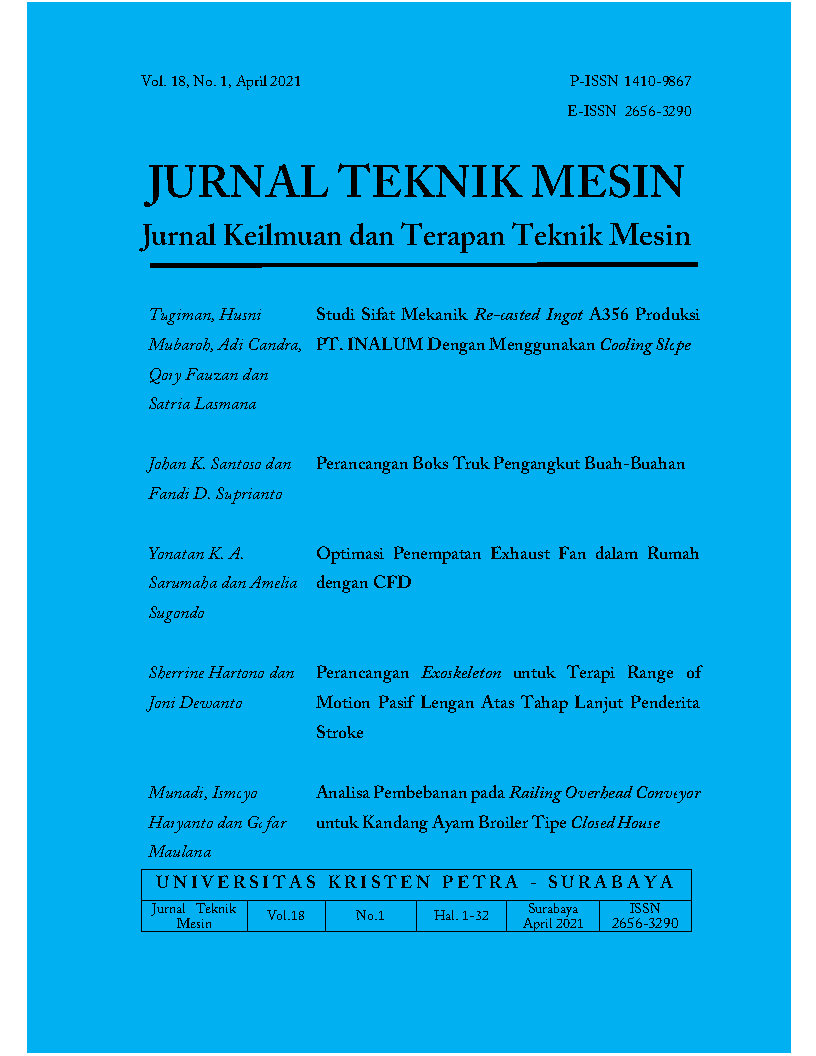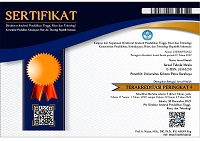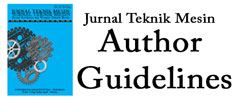Remanufacturing: Strategi dan Desain dalam Rantai Pasok Lingkaran Tertutup
 :
:
https://doi.org/10.9744/jtm.18.2.51-59
Keywords:
Remanufaktur, closed-loop supply chain, strategy, designAbstract
Remanufaktur adalah proses pemulihan barang bekas yang memberikan preservasi tertinggi terhadap nilai tambah produk originalnya, proses ini mentransformasikan barang bekas menjadi “seperti baru” dan seringkali dikembalikan ke pasar dengan garansi yang ekuivalen seperti produk baru. Praktik remanufaktur ini dapat memberikan dampak positif terhadap lingkungan karena dapat mengurangi limbah yang dibuang ke tempat pembuangan akhir. Namun remanufaktur juga memiliki banyak tantangan, tidak hanya dalam aspek teknikal dan operasional, tetapi juga pada aspek strategi dan desain. Makalah ini menyajikan pendekatan konseptual berdasarkan tinjauan literatur untuk menjawab tantangan remanufaktur dalam rantai pasok lingkaran tertutup, serta mengusulkan strategi dan desain implementasinya. Pendekatan yang digunakan adalah qualitative content analysis untuk mengidentifikasi berbagai konsep dan membagi dalam kategori yang sesuai. Hasil analisis menunjukkan bahwa implementasi remanufaktur dalam rantai pasok lingkaran tertutup dapat diterapkan dengan penentuan motif dan pendorong, dimensi keputusan remanufaktur, strategi implementasi remanufaktur, desain produk dan proses, serta desain jaringan.
References
Steinhilper, R., 1998. “Remanufacturing - The Ultimate Form of Recycling”, Fraunhofer IRB Verlag.
Guide, V.D.R.J., Teunter, R.H. & Wassenhove, L.N. Van, 2003. “Matching Demand and Supply to Maximize Profits from Remanufacturing”. Manufacturing & Service Operations Management, 5(4), pp. 303–316.
Neto, J.Q.F. & Bloemhof-Ruwaard, J.M., 2012. An Analysis of the Eco-Efficiency of Personal Computers and Mobile Phones. Production and Operations Management, 21(1), pp.101–114.
Haynsworth, H.C. & Lyons, R.T., 1987. “Remanufacturing by design, the missing link”. Production and Inventory Management, 2, pp.24–28.
Amezquita, T., Hammond, R., Salazar, M. and Bras, B., 1995, September. Characterizing the remanufacturability of engineering systems. In International Design Engineering Technical Conferences and Computers and Information in Engineering Conference (Vol. 17162, pp. 271-278). American Society of Mechanical Engineers.
Lindahl, M., Sundin, E. & Ostlin, J., 2006. “Environmental Issues within the Remanufacturing Industry”. In 13th CIRP International conference on Life Cycle Engineering, Leuven. pp. 447–452.
Lund, R.T. and Hauser, W.M., 2010, January. Remanufacturingan American perspective. In 5th International Conference on Responsive Manufacturing-Green Manufacturing (ICRM 2010) (pp. 1-6). IET.
Ijomah, W.L., Childe, S. & McMahon, C., 2004. “Remanufacturing: A Key Strategy for Sustai¬nable Development”. In Proceedings of the 3rd International Conference on Design and Manufacture for Sustainable Development, 1-2 Sep¬tember, 2004, Loughborough, UK.
Sundin, E. & Bras, B., 2005. “Making functional sales environmentally and economically beneficial through product remanufacturing”. Journal of Cleaner Production,13, pp.913–925.
Gray, C. & Charter, M., 2008. “Remanufacturing and Product Design”. International Journal of Product Development, 6(3-4), pp.375–392.
Nasr, N., Russell, J., Bringezu, S., Hellweg, S., Hilton, B., Kreiss, C. and Von Gries, N., 2018. “Re-defining Value–The Manufacturing Revolution”. Remanufacturing, Refurbishment, Repair and Direct Reuse in the Circular Economy.
Guide, V.D.R.J., Jayaraman, V. & Linton, J.D., 2003. “Building contingency planning for closed-loop supply chains with product recovery”. Journal of Operations Management, 21, pp.259–279.
Ferguson, M.E. & Souza, G.C., 2010. “Closed-loop supply Chains - New Developments to Improve the Sustainability of Business Practices”, CRC Press.
Pochampally, K.K., Nukala, S. & Gupta, S.M., 2009. “Strategic Planning Models for Reverse and Closed-Loop Supply Chain”, CRC Press.
Lebreton, B., 2007. “Strategic Closed-Loop Supply Chain Management”. In Lecture Notes in Economics and Mathematical Systems 586. Springer Berlin Heidelberg, pp. 1–158.
Le Blanc, H.M., 2006. Closing loops in supply chain management: Designing reverse supply chains for end-of-life vehicles. Tilburg University, School of Economics and Management.
Guide, V.D.R.J. & Wassenhove, L.N. Van, 2006. “Closed-Loop Supply Chains: An Introduction to the Feature Issue (Part 1)”. Production and Operations Management, 15(3), pp.345–350.
Thierry, M. et al., 1995. “Strategic issues in pro¬duct recovery management”. California Management Review, 37(2), pp.114–135.
De Brito, M.P. & Dekker, R., 2003. “Modelling product returns in inventory control — exploring the validity of general assumptions”. International Journal of Production Economics, 81-82, pp.225–241.
Guide, V.D.R.J. & Wassenhove, L.N. Van, 2009. “The Evolution of Closed-Loop Supply Chain Research”. Operations Research, 57(1), pp.10–18.
Seitz, M.A. & Wells, P.E., 2006. “Challenging the implementation of corporate sustainability The case of automotive engine”. Business Process Management Journal, 12(6), pp.822–836.
Kumar, S. & Putnam, V., 2008. “Cradle to cradle: Reverse logistics strategies and opportunities across three industry sectors”. International Journal of Production Economics, 115(2), pp. 305–315.
Heese, H.S. et al., 2005. “Competitive advantage through take-back of used products”. European Journal of Operational Research, 164(1), pp. 143–157.
Inderfurth, K., 2005. “Impact of uncertainties on recovery behavior in a remanufacturing environment - A numerical analysis”. International Journal of Physical Distribution & Logistics Management, 35(5), pp.318–336.
Webster, S. & Mitra, S., 2007. “Competitive strategy in remanufacturing and the impact of take-back laws”. Journal of Operations Manage¬ment, 25, pp.1123–1140.
Bose, I. & Pal, R., 2012. “Do green supply chain management initiatives impact stock prices of firms?” Decision Support Systems, 52(3), pp.624–634.
Debo, L.G., Toktay, L.B. & Wassenhove, L.N. Van, 2005. “Market Segmentation and Product Technology Selection for Remanufacturable Pro-ducts”. Management Science, 51(8), pp.1193–1205.
Seitz, M.A. & Wells, P.E., 2006. “Challenging the implementation of corporate sustainability The case of automotive engine”. Business Process Management Journal, 12(6), pp.822–836.
Ferguson, M.E. & Toktay, L.B., 2006. “The Effect of Competition on Recovery Strategies”. Production and Operations Management, 15(3), pp. 351–368.
Kapetanopoulou, P. & Tagaras, G., 2009. “An empirical investigation of value-added product recovery activities in SMEs using multiple case studies of OEMs and independent remanufacturers”. Flexible Services and Manufacturing Journal, 21, pp.92–113.
Subramoniam, R., Huisingh, D. & Chinnam, R.B., 2010. “Aftermarket remanufacturing strategic planning decision-making framework: theory & practice”. Journal of Cleaner Production, 18(16-17), pp.1575–1586.
Kuik, S.S., Nagalingam, S.V. & Amer, Y., 2011. “Sustainable supply chain for collaborative manufacturing”. Journal of Manufacturing Technology Management, 22(8), pp.984–1001.
Georgiadis, P. & Vlachos, D., 2004. “The effect of environmental parameters on product recovery”. European Journal of Operational Research, 157(2), pp.449–464.
Robotis, A., Boyaci, T. & Verter, V., 2012. “Investing in reusability of products of uncertain remanufacturing cost: The role of inspection capabilities”. International Journal of Produc¬tion Economics, 140(1), pp.385–395.
Georgiadis, P. & Athanasiou, E., 2013. “Flexible long-term capacity planning in closed-loop supply chains with remanufacturing”. European Journal of Operational Research, 225(1), pp.44–58.
Guide, V.D.R.J., Muyldermans, L. & Wassen¬hove, L.N. Van, 2005. “Hewlett-Packard Company Unlocks the Value Potential from Time-Sensitive Returns”. Interfaces, 35(4), pp.281–293.
Ostlin, J., Sundin, E. & Bjorkman, M., 2009. “Pro-duct life-cycle implications for remanufacturing strategies”. Journal of Cleaner Produc¬tion, 17(11), pp.999–1009.
Ordoobadi, S.M., 2009. “Outsourcing reverse logistics and remanufacturing functions: a conceptual strategic model”. Management Rese¬arch News, 32(9), pp.831–845.
Kleber, R., 2006. “The integral decision on production/ remanufacturing technology and investment time in product recovery”. OR Spec-trum, 28, pp.21–51.
Jiang, Z., Zhang, H. & Sutherland, J.W., 2011. “Development of multi-criteria decision making model for remanufacturing technology portfolio selection”. Journal of Cleaner Production, 19(17-18), pp.1939–1945.
Pialot, O., Millet, D. & Tchertchian, N., 2012. “How to explore scenarios of multiple upgrade cycles for sustainable product innovation: the “Upgrade Cycle Explorer” tool”. Journal of Cleaner Production, 22(1), pp.19–31.
Wu, C.-H., 2013. “OEM product design in a price competition with remanufactured product”. Omega, 41, pp.287–298.
Dong, S., Xu, B., Wang, Z., Ma, Y. and Liu, W., 2008, January. “Laser remanufacturing technology and its applications”. In Lasers in Material Processing and Manufacturing III (Vol. 6825, p. 68251N). International Society for Optics and Photonics.
Yeo, N.C.Y., Pepin, H. and Yang, S.S., 2017. “Revolutionizing technology adoption for the remanufacturing industry”. Procedia CIRP, 61, pp.17-21.
Kerin, M. and Pham, D.T., 2020. “Smart remanufacturing: a review and research frame-work”. Journal of Manufacturing Technology Management, 31(6), pp.1205-1235.
Lee, C.K.M. & Chan, T.M., 2009. “Development of RFID-based Reverse Logistics System”. Expert Systems With Applications, 36(5), pp.9299–9307.
Ji, G., 2011. “Effective Implementation of WEEE Take-back Directive: What Types of Take-back Network Patterns in China”. Systems Engineering Procedia, 2, pp.366–381.
Srivastava, S.K., 2008. “Value recovery network design for product returns”. International Journal of Physical Distribution & Logistics Mana¬gement, 38(4), pp.311–331.
Francas, D. & Minner, S., 2009. “Manufacturing network configuration in supply chains with product recovery”. Omega, 37(4), pp.757–769.
Alumur, S.A. et al., 2012. “Multi-period reverse logistics network design”. European Journal of Operational Research, 220(1), pp.67–78.
Downloads
Published
Issue
Section
License
Jurnal Teknik Mesin diterbitkan oleh Universitas Kristen Petra.
![]()
Artikel dan semua materi yang diterbitkan terkait didistribusikan di bawah Lisensi Internasional Creative Commons Attribution License (CC BY).



















